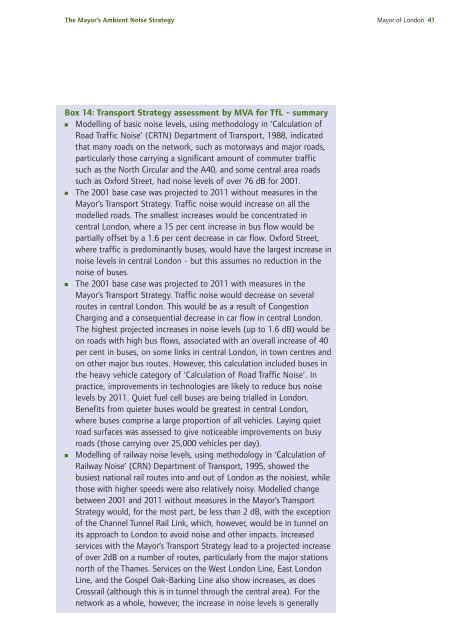The Mayor's Ambient Noise Strategy - Greater London Authority
The Mayor's Ambient Noise Strategy - Greater London Authority
The Mayor's Ambient Noise Strategy - Greater London Authority
You also want an ePaper? Increase the reach of your titles
YUMPU automatically turns print PDFs into web optimized ePapers that Google loves.
<strong>The</strong> Mayor’s <strong>Ambient</strong> <strong>Noise</strong> <strong>Strategy</strong> Mayor of <strong>London</strong> 41<br />
Box 14: Transport <strong>Strategy</strong> assessment by MVA for TfL - summary<br />
■ Modelling of basic noise levels, using methodology in ‘Calculation of<br />
Road Traffic <strong>Noise</strong>’ (CRTN) Department of Transport, 1988, indicated<br />
that many roads on the network, such as motorways and major roads,<br />
particularly those carrying a significant amount of commuter traffic<br />
such as the North Circular and the A40, and some central area roads<br />
such as Oxford Street, had noise levels of over 76 dB for 2001.<br />
■ <strong>The</strong> 2001 base case was projected to 2011 without measures in the<br />
Mayor’s Transport <strong>Strategy</strong>. Traffic noise would increase on all the<br />
modelled roads. <strong>The</strong> smallest increases would be concentrated in<br />
central <strong>London</strong>, where a 15 per cent increase in bus flow would be<br />
partially offset by a 1.6 per cent decrease in car flow. Oxford Street,<br />
where traffic is predominantly buses, would have the largest increase in<br />
noise levels in central <strong>London</strong> - but this assumes no reduction in the<br />
noise of buses.<br />
■ <strong>The</strong> 2001 base case was projected to 2011 with measures in the<br />
Mayor’s Transport <strong>Strategy</strong>. Traffic noise would decrease on several<br />
routes in central <strong>London</strong>. This would be as a result of Congestion<br />
Charging and a consequential decrease in car flow in central <strong>London</strong>.<br />
<strong>The</strong> highest projected increases in noise levels (up to 1.6 dB) would be<br />
on roads with high bus flows, associated with an overall increase of 40<br />
per cent in buses, on some links in central <strong>London</strong>, in town centres and<br />
on other major bus routes. However, this calculation included buses in<br />
the heavy vehicle category of ‘Calculation of Road Traffic <strong>Noise</strong>’. In<br />
practice, improvements in technologies are likely to reduce bus noise<br />
levels by 2011. Quiet fuel cell buses are being trialled in <strong>London</strong>.<br />
Benefits from quieter buses would be greatest in central <strong>London</strong>,<br />
where buses comprise a large proportion of all vehicles. Laying quiet<br />
road surfaces was assessed to give noticeable improvements on busy<br />
roads (those carrying over 25,000 vehicles per day).<br />
■ Modelling of railway noise levels, using methodology in ‘Calculation of<br />
Railway <strong>Noise</strong>’ (CRN) Department of Transport, 1995, showed the<br />
busiest national rail routes into and out of <strong>London</strong> as the noisiest, while<br />
those with higher speeds were also relatively noisy. Modelled change<br />
between 2001 and 2011 without measures in the Mayor’s Transport<br />
<strong>Strategy</strong> would, for the most part, be less than 2 dB, with the exception<br />
of the Channel Tunnel Rail Link, which, however, would be in tunnel on<br />
its approach to <strong>London</strong> to avoid noise and other impacts. Increased<br />
services with the Mayor’s Transport <strong>Strategy</strong> lead to a projected increase<br />
of over 2dB on a number of routes, particularly from the major stations<br />
north of the Thames. Services on the West <strong>London</strong> Line, East <strong>London</strong><br />
Line, and the Gospel Oak-Barking Line also show increases, as does<br />
Crossrail (although this is in tunnel through the central area). For the<br />
network as a whole, however, the increase in noise levels is generally
















